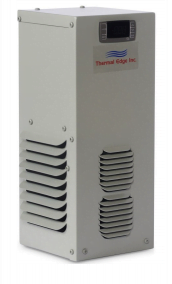When Is it Necessary to Select an Air Conditioner for Your Electrical Enclosure?
 Electrical enclosures are generally designed to allow cooling by natural ventilation, supplemented sometimes by forced ventilation. This usually works well, but there are situations when overheating of electrical panels occurs due to internal heat load, environmental, ventilation, and air flow capacity constraints.
Electrical enclosures are generally designed to allow cooling by natural ventilation, supplemented sometimes by forced ventilation. This usually works well, but there are situations when overheating of electrical panels occurs due to internal heat load, environmental, ventilation, and air flow capacity constraints.
In these situations, enclosure air conditioners solve high temperature problems inside electrical enclosures, increasing component life and reducing the risk of overheating leading to component failure.
Heat Load
The heat load of an electrical enclosure is the heat generated in that cabinet, usually expressed in Watts. Sources of heat generation include:
- Electrical equipment: The efficiency of power supplies, servo drives, motor drives, and transformers ranges from 85 to 95 percent. The 5 and 15 percent of energy lost is converted to heat.
- Solar load: Solar radiation significantly adds to the heat load in outdoor enclosures.
- Ambient heat: Enclosures located in a hot environment absorb heat from that environment.
Hot Industrial Environments
Electrical enclosures placed in hot industrial environments, for example, near ovens, kilns, and furnaces cannot depend on natural cooling because ambient air temperature is close to or above optimum electrical equipment temperatures and items such as electrical drives, which are susceptible to overheating, may malfunction or fail. Although the maximum operating temperature of some devices reaches 140 °F, many others cannot exceed 120 °F. In all cases, component life is extended and doubled for every 10 °F decrease in operating temperature. Electrical enclosure air conditioning is the only viable method of maintaining safe electrical equipment operating temperatures in a hot industrial environment.
Hot Outdoor Climates
The effect of solar radiation on metal equipment is such that in hot climates surface temperatures of metal objects can easily exceed 100 °F. In these conditions, natural ventilation may be insufficient to prevent internal temperatures of electrical enclosures from reaching unsafe levels. These situations are common in hot, dry, tropical, and sub-tropical areas. When enclosures must be outdoors an enclosure air conditioner may be required.
Dusty Environments
Electrical equipment in dusty environments needs to be properly enclosed and natural ventilation is not recommended as dirt and dust can affect operation of the moving parts of relays and contactors. Some dusts may be corrosive or conducting and need to be kept away from electrical components. The best method of equipment protection is the use of sealed electrical enclosures provided with suitably equipped enclosure air conditioners designed for use in dusty environments.
Poorly Ventilated Areas
Electrical enclosures in poorly ventilated areas may overheat if the heat load from the electrical equipment inside the enclosure is excessive. Electronic equipment used to control motors produce a lot of waste heat that needs to be dissipated, or the enclosure may overheat. Other heat sources are electronic power supplies and air cooled transformers. An enclosure air conditioner will remove the excess heat from electrical enclosures and keep them cool.
Space Constraints
In some situations, space available for electrical panels is constricted. Examples include electrically powered coal and ore reclaiming equipment, mining equipment, earth moving equipment, and ships. Often this equipment is supplied at medium voltage power using a trailing cable or overhead pantograph and makes extensive use of variable speed drives. Enclosure air conditioning can be used to keep these electrical enclosure temperatures within operating parameters.
High Electrical Enclosure Temperatures Can Be Dangerous
The risk arising from the overheating of electrical components in panels cannot be under estimated. Many devices cannot withstand temperatures above 140 °F (60 °C) and electrical enclosures may achieve these temperatures in harsh environments with high ambient heat loads and poor ventilation.
Once a temperature of 140 °F is reached, conductor resistance increases, leading to severe localized overheating especially of components carrying large currents. Thermal runaway becomes a distinct possibility which may lead to components burning out and a subsequent risk of fire and explosion. Air conditioning of electrical enclosures can prevent component temperatures from exceeding safe levels and has the added benefit that cooler running extends the life of the electrical equipment.
Extend the life of electrical components in your application by contacting Thermal Edge experts today to select an air conditioner suited to your enclosure and application.


